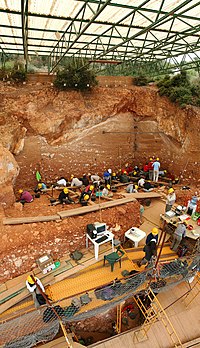Archaeological site
An archaeological site (from French gisement; also called an settlement, area, or archaeological site ) is a concentration of archaeological remains (materials, structures and environmental remains). In it we can find a concentration of remains of human activity and it is constituted by the presence of artifacts, structural elements, occupation soils and another series of anomalies. These remains can be found by a mere surface survey or, if the settlement has been buried, by a subsurface survey.
Reservoir formation
The deposits are formed by processes of abandonment or burial some times and other times because it is razed to continue living on top (continuous occupation). The tells is an example of a deposit of various occupations. Physical, biological and cultural processes are involved in its formation:
- Physical: on the occasion of erosion (water, wind, ice) which carries with it a transfer of sediments made by the wind.
- Chemicals: sometimes originate mineral soils of organic origin. Chromatomatic analysis and trace element studies are used to see animal fat, feces... which allows different soils.
- Biological: due to animal activity, such as excrement, food or transfer of prey.
- Cultural: due to human activity, it can be mineral extraction, food search, cultivation, hydraulic constones... and unimaginable
Tells
The most significant deposits that best show their formation are the tells. In the east there are these types of habitat deposits, used with some material such as adobe, and that over time form false hills. We have some examples such as Çatalhöyük.
Classifications of deposits
Archaeological sites are classified according to certain criteria:
- Chronological: according to the great cultural stages with phases and periods: paleolithic, neolithic, mesolytic... Also in relation to cultures: Sumeria, Acad, Egypt, Greece, Mesoamerica, etc...
- Functional: Habitat and necropolis are distinguished. Community activities such as eating and relating are carried out in habitats. At first they leave hardly traces (bones, useful, ash), but with evolution it becomes more complex (branches with branches). With urbanization the level of complexity is enormous and diversifies: urban, rural, concentrated and diverse. Necropolises: they worship the deceased, at first they are simple graves that become more complex; there are burials of incineration or inhumation, collective or individual.
- Type: according to its topographical situation: outdoors, in cave, valley...
- Duration: temporary, seasonal, fixed or not.
Types of actions in deposits
The Spanish regulations (Reglamento de Actividades Arqueológicas) establish six types of activities in archaeological sites, which require authorization.
Archaeological excavation
It can be both terrestrial and underwater, understood as the removal of earth and the analysis of structures carried out with scientific methodology, aimed at discovering and investigating all kinds of historical or paleontological remains, as well as the geomorphological components related to them.
Archaeological survey
It is the superficial and systematic exploitation carried out with scientific methodology, both terrestrial and underwater, aimed at the study, investigation or detection of archaeological or paleontological remains.
History
It began to be practiced in the 1930s. XX as utility to know the national patrimony. It is less slow and expensive and allows you to collect a lot of information with little effort and money. In Spain, it begins between 1930-1940 to learn about the heritage of each province. Blas Taracena makes the first archaeological map in Soria, later they will be made in Barcelona, Valladolid...
Something similar occurs in Europe, as research was carried out in the 60s in a systematic way. Territories were covered in an organized way, studying maps and conducting surveys. From the 80s the methods are perfected and prospecting is not done freely, apart from being planned.
Interventions in rock art
Includes the reproduction and direct study of rock art, understood as the set of research-oriented field work, graphic documentation or, exceptionally, any type of manipulation or contact with the support of figurative motifs.
Other activities
In addition to the above, the following activities must also be authorized when carried out in archaeological sites:
- of archaeological consolidation, restoration and restitution,
- archeological actions of lock, fence and cover,
- study and graphical documentation of the deposits, as well as of the materials deposited in museums.
Legal regulation in Spain
State regulations
The Law 16/1985 of June 25, on Spanish Historical Heritage, establishes the protection as Historical Heritage of archaeological sites, under the legal figure of BIC (Asset of Cultural Interest), with the category of Archaeological Site.
Article 15.5 defines it as: place or natural area where there are movable or immovable assets that can be studied with archaeological methodology, whether or not they have been extracted, and whether they are found on the surface, in the subsoil or under Spanish territorial waters.
Any work or removal of land that is projected in these Archaeological Zones must be authorized by the competent Administration.
Likewise, any archaeological activity, whether extractive or not, must be authorized by the competent authority. Carrying out prospecting or excavations without authorization is classified as a serious administrative offense, and can become a criminal offense, if it involves plunder.
Autonomous regulations
Powers on authorization and control, both of archaeological activities, as well as works carried out in archaeological sites, are decentralized in the autonomous communities.
Andalusia
Archaeological sites, their protection and the activities carried out in them are regulated by Law 14/2007, of November 26, on the Historical Heritage of Andalusia and by Regulation of Archaeological Activities (Decree 168/2003).
These regulations also refer to Archaeological Zones, which they simply define as those clearly delimited spaces in which the existence of archaeological remains of relevant interest has been verified.
It also regulates the Archaeological Servitude Areas, such as those spaces in which the existence of archaeological remains of interest is reasonably presumed and it is considered necessary to adopt precautionary measures.
Contenido relacionado
Harappa
Carthaginian necropolis in Ibiza
Xochicalco


